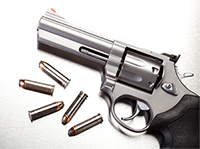 The NFA was originally enacted in 1934. Similar to the current NFA, the original Act imposed a tax on the making and transfer of firearms defined by the Act, as well as a special (occupational) tax on persons and entities engaged in the business of importing, manufacturing, and dealing in NFA firearms. The law also required the registration of all NFA firearms with the Secretary of the Treasury. Firearms subject to the 1934 Act included shotguns and rifles having barrels less than 18 inches in length, certain firearms described as “any other weapons,” machine guns, and firearm mufflers and silencers.
The NFA was originally enacted in 1934. Similar to the current NFA, the original Act imposed a tax on the making and transfer of firearms defined by the Act, as well as a special (occupational) tax on persons and entities engaged in the business of importing, manufacturing, and dealing in NFA firearms. The law also required the registration of all NFA firearms with the Secretary of the Treasury. Firearms subject to the 1934 Act included shotguns and rifles having barrels less than 18 inches in length, certain firearms described as “any other weapons,” machine guns, and firearm mufflers and silencers.
While the NFA was enacted by Congress as an exercise of its authority to tax, the NFA had an underlying purpose unrelated to revenue collection. As the legislative history of the law discloses, its underlying purpose was to curtail, if not prohibit, transactions in NFA firearms. Congress found these firearms to pose a significant crime problem because of their frequent use in crime, particularly the gangland crimes of that era such as the St. Valentine’s Day Massacre. The $200 making and transfer taxes on most NFA firearms were considered quite severe and adequate to carry out Congress’ purpose to discourage or eliminate transactions in these firearms. The $200 tax has not changed since 1934.
As structured in 1934, the NFA imposed a duty on persons transferring NFA firearms, as well as mere possessors of unregistered firearms, to register them with the Secretary of the Treasury. If the possessor of an unregistered firearm applied to register the firearm as required by the NFA, the Treasury Department could supply information to State authorities about the registrant’s possession of the firearm. State authorities could then use the information to prosecute the person whose possession violated State laws. For these reasons, the Supreme Court in 1968 held in the Haynes case that a person prosecuted for possessing an unregistered NFA firearm had a valid defense to the prosecution — the registration requirement imposed on the possessor of an unregistered firearm violated the possessor’s privilege from self-incrimination under the Fifth Amendment of the U.S. Constitution. The Haynes decision made the 1934 Act virtually unenforceable.
Title II of the Gun Control Act (GCA) of 1968
Title II amended the NFA to cure the constitutional flaw pointed out in Haynes. First, the requirement for possessors of unregistered firearms to register was removed. Indeed, under the amended law, there is no mechanism for a possessor to register an unregistered NFA firearm already possessed by the person. Second, a provision was added to the law prohibiting the use of any information from an NFA application or registration as evidence against the person in a criminal proceeding with respect to a violation of law occurring prior to or concurrently with the filing of the application or registration. In 1971, the Supreme Court reexamined the NFA in the Freed case and found that the 1968 amendments cured the constitutional defect in the original NFA.
Title II also amended the NFA definitions of “firearm” by adding “destructive devices” and expanding the definition of “machine gun.”
Firearm Owners’ Protection Act
In 1986, this Act amended the NFA definition of “silencer” by adding combinations of parts for silencers and any part intended for use in the assembly or fabrication of a silencer. The Act also amended the GCA to prohibit the transfer or possession of machine guns. Exceptions were made for transfers of machine guns to, or possession of machine guns by, government agencies, and those lawfully possessed before the effective date of the prohibition, May 19, 1986.

